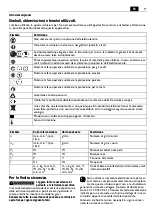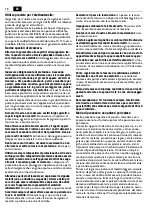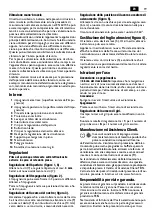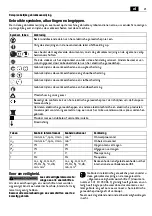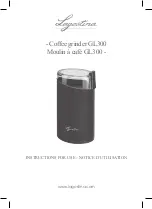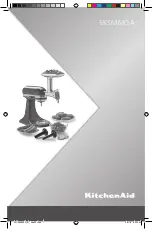
10
en
Intended use of the power tool:
Hand-guided grinder for belt grinding in weather-pro-
tected environments with the application tools and acces-
sories recommended by GRIT.
This power tool is also suitable for use with AC genera-
tors with sufficient power output that correspond to the
Standard ISO 8528, design type G2. This Standard is par-
ticularly not complied with when the so-called distortion
factor exceeds 10 %. When in doubt, please refer to the
generator instruction/specification guide.
Special safety instructions.
Hold power tool by insulated gripping surfaces, because
the belt may contact its own cord.
Cutting a “live” wire
may make exposed metal parts of the power tool “live”
and could give the operator an electric shock.
Wear personal protective equipment. Depending on appli-
cation, use face shield, safety goggles or safety glasses.
Where appropriate, wear dust mask, hearing protectors,
gloves and workshop apron capable of stopping small
abrasive or workpiece fragments.
The eye protection
must be capable of stopping flying debris generated by
various operations. The dust mask or respirator must be
capable of filtrating particles generated by your opera-
tion. Prolonged exposure to high intensity noise may
cause hearing loss.
While working, do not wear loose clothing, jewellery or
open, long hair.
Despite protective devices, loose objects
can be snagged or caught by moving parts and lead to injury.
Do not use worn, torn or heavily clogged grinding belts.
Handle grinding belts carefully and store them according
to the manufacturer’s instructions. Do not bend or fold
grinding belts!
Damaged grinding belts can tear, be flung
away and injure someone.
Never touch the running grinding belt and do not reach
under the protective guard.
Danger of injury.
Always use the protective devices attached on the
machine. The protective devices must be securely
mounted to the machine in order to achieve maximum
safety.
The protective devices are supposed to protect
the user from grinding particles thrown from the machine
and from accidental contact with the grinding belt.
Warning! Danger of fire and explosion! When grinding
metals (e.g., aluminium or magnesium), dust develops
that may be combustible or explosive. Do not operate the
machine near flammable materials.
Sparks could cause
these materials to ignite.
Pay attention that other persons are not put at risk from
sparking.
Remove flammable materials in close vicinity.
Sparking occurs when grinding metal.
Secure the work piece firmly.
A work piece that is
gripped tightly in a clamping device or vice, is more
secure than if held by hand.
Hold the power tool firmly.
High reaction torque can
briefly occur.
Never touch the running grinding belt.
Danger of injury.
Do not rivet or screw any name-plates or signs onto the
power tool.
If the insulation is damaged, protection
against an electric shock will be ineffective. Adhesive
labels are recommended.
Do not use accessories which are not specifically
designed and recommended by the power tool manufac-
turer.
Safe operation is not ensured merely because an
accessory fits your power tool.
Clean the ventilation openings on the power tool at regu-
lar intervals using non-metal tools.
The blower of the
motor draws dust into the housing. An excessive accu-
mulation of metallic dust can cause an electrical hazard.
Before putting into operation, check the mains connec-
tion and the mains plug for damage.
Recommendation: The tool should always be supplied
with power via a residual current device (RCD) with a
rated current of 30 mA or less.
Handling hazardous dusts
For work procedures with this power tool where mate-
rial is removed, dusts develop that can be hazardous to
one’s health.
Contact with or inhaling some dust types, e. g. asbestos
and asbestos-containing materials, lead-containing coat-
ings, metal, some wood types, minerals, silicate particles
from materials containing stone, paint solvents, wood
preservatives, antifouling paints for vessels, can trigger
allergic reactions to the operator or bystanders and/or
lead to respiratory infections, cancer, birth defects or
other reproductive harm. The risk from inhaling dusts
depends on the exposition. Use dust extraction matched
appropriately for the developing dust, as well as personal
protective equipment and provide for good ventilation of
the workplace. Leave the processing of asbestos-contain-
ing materials to specialists.
Wood and light-metal dust, hot mixtures of grinding dust
and chemical materials can self-ignite under unfavourable
conditions or cause an explosion. Avoid sparking in the
direction of the dust collector as well as overheating of
the power tool and the materials being sanded, empty the
dust collector/container in time, observe the material
manufacturer’s working instructions, as well as the rele-
vant regulations in your country for the materials being
worked.
Hand/arm vibrations
The vibration emission level given in this information
sheet has been measured in accordance with a standard-
ised test given in EN 60745 and may be used to compare
one tool with another. It may be used for a preliminary
assessment of exposure.
The declared vibration emission level represents the
main applications of the tool. However, if the tool is used
for different applications, with different accessories or
poorly maintained, the vibration emission may differ.
This may significantly increase the exposure level over
the total working period.
An estimation of the level of exposure to vibration
should also take into account the times when the tool is
switched off or when it is running but not actually doing
the job. This may significantly reduce the exposure level
over the total working period.
Identify additional safety measures to protect the opera-
tor from the effects of vibration such as: maintain the tool
and the accessories, keep the hands warm, organisation
of work patterns.
Содержание GRIT GHB 15-50
Страница 3: ...3 2 1 3 4 5 6 7 8 10 9 11 12 13 1 14 ...
Страница 4: ...4 2 3 4 5 6 max 4 mm B B ...

















